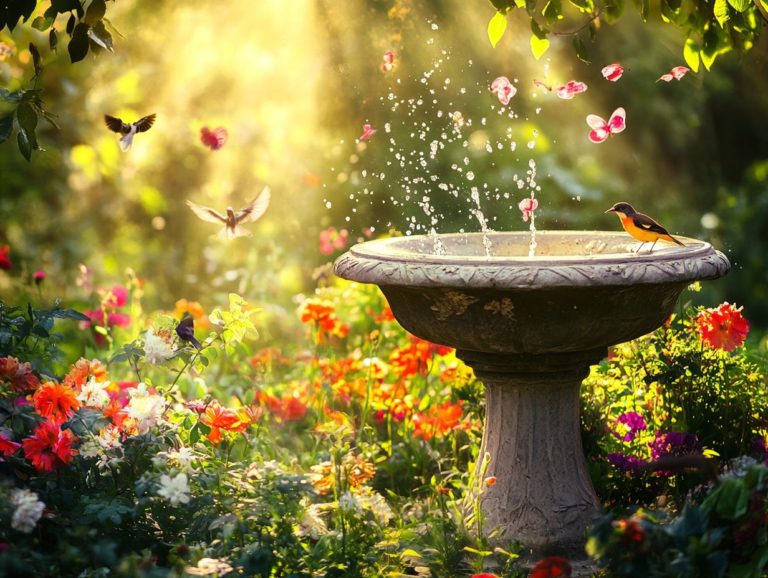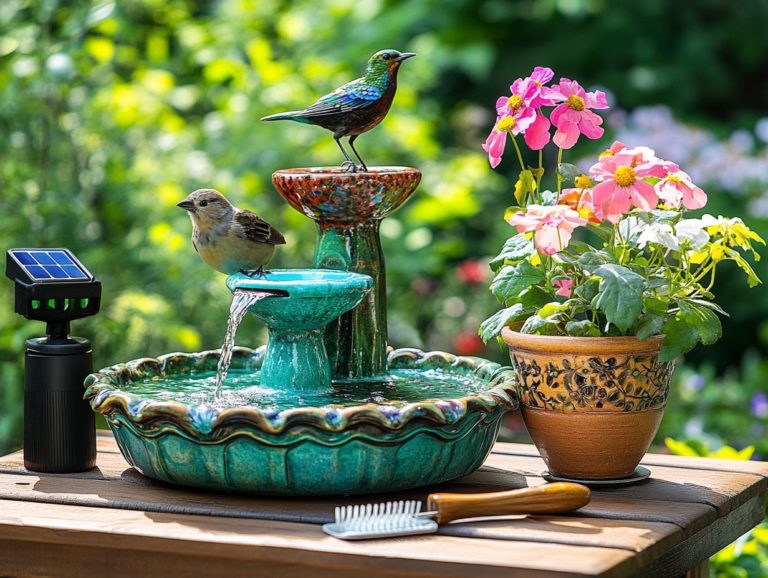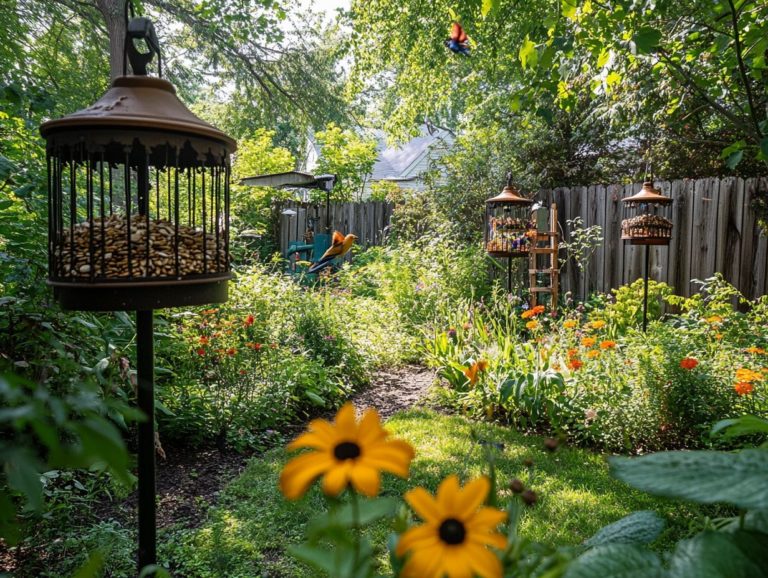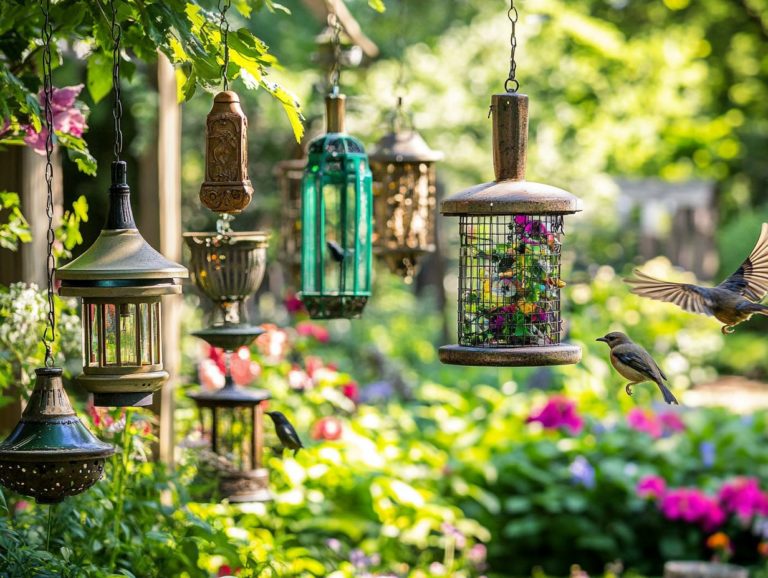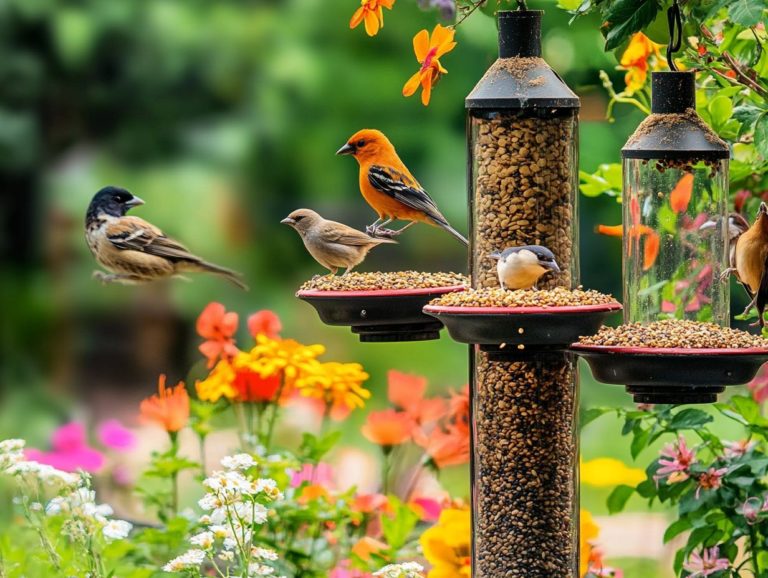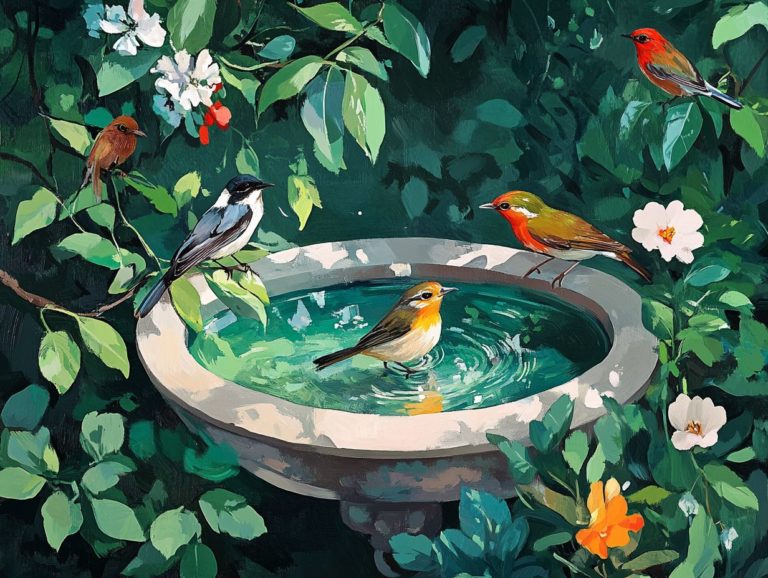The Impact of Bird Feeders on Local Wildlife
Bird feeders are an excellent way to invite feathered friends into your backyard, but their impact on local wildlife can be more nuanced than it appears.
While they provide valuable extra feeding, incorporating native plants attracts pollinators and enhances the ecological balance within your local environment by providing natural food sources and nesting sites. However, they can also introduce challenges for both birds and the surrounding ecosystem.
This article explores the pros and cons of bird feeders. Bird feeders are an essential part of the bird feeding industry and can have both positive and negative effects on local wildlife. Therefore, it’s important to use them carefully and responsibly. This discussion offers best practices for their effective use and suggests natural alternatives to attract birds.
Discover how to support local wildlife and make your yard a birds paradise!
Contents
- The Effects of Bird Feeders on Local Wildlife
- How to Properly Use Bird Feeders
- Alternatives to Bird Feeders
- Frequently Asked Questions
- What is the impact of bird feeders on local wildlife?
- Are there any negative effects of bird feeders on local wildlife?
- How do bird feeders affect the behavior of local wildlife?
- Want to protect local wildlife while enjoying your bird feeders? Here s how!
- Do bird feeders attract other types of wildlife besides birds?
- Can I still feed birds without using a bird feeder?
Key Takeaways:
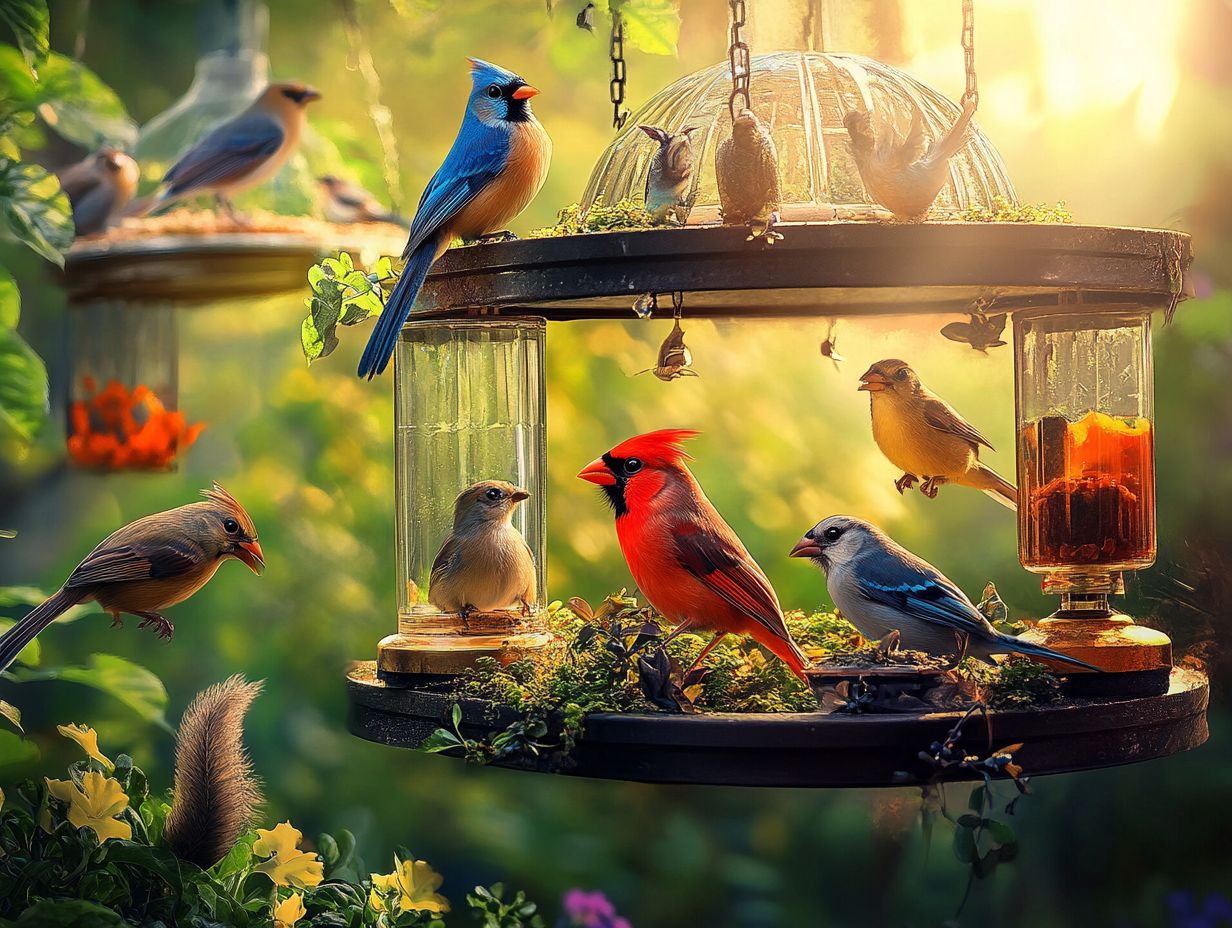
- Bird feeders impact local wildlife in both positive and negative ways. Use them wisely!
- Choose the right feeder to minimize waste and boost bird health.
- Consider planting native plants as a natural way to attract birds.
What are Bird Feeders?
Bird feeders are expertly crafted devices that serve as vital food sources for wild birds. They allow you to enjoy backyard wildlife watching while promoting optimal bird nutrition. Available in a variety of styles, these feeders are essential for extra feeding, particularly during harsh weather or periods when natural food is scarce. By selecting the right bird feeders, you can attract a diverse array of birds and transform your outdoor space into a thriving wildlife sanctuary.
For example:
- Tube feeders are perfect for smaller birds like finches and chickadees.
- Platform feeders offer ample space for larger species to land and feast.
- Suet feeders draw in insect-eating birds, providing crucial energy sources during the colder months.
Some feeders dispense seeds that match specific bird preferences, catering to their unique dietary needs. By adopting thoughtful bird feeding practices, you can significantly enhance the local bird community, fostering an environment where various species interact harmoniously and thrive.
By practicing thoughtful bird feeding, you can transform your yard into a vibrant wildlife sanctuary where birds thrive. Let s make a difference together!
The Effects of Bird Feeders on Local Wildlife
The impact of bird feeders on local wildlife can be a double-edged sword, influenced by factors such as feeder design, maintenance, and the surrounding environment, highlighting the role of bird feeders in ecosystems.
On one hand, these feeders can serve as a vital lifeline, offering a consistent food source for wild birds. They allow you to enjoy backyard wildlife watching while promoting optimal avian nutrition. By embracing these practices, you can nurture vibrant avian communities and make a positive contribution to your local ecosystems.
However, these feeders can also create ecological challenges. Inappropriate feeding practices may lead to reliance on human-provided food, which can disrupt natural foraging behavior and even alter migration patterns. When left unmanaged, these feeders might contribute to habitat loss by attracting certain bird species that upset the ecological balance of local ecosystems.
Additionally, they may heighten disease transmission among birds. Regularly cleaning your feeders is essential for wildlife conservation, as it helps prevent the spread of diseases among visiting birds and supports native wildlife.
Understanding these dynamics helps you support wildlife conservation efforts and promotes the health and well-being of the birds you admire.
Positive Effects
Bird feeders are a fantastic way to help local wildlife thrive! They offer numerous benefits, significantly enhancing bird health and cultivating a vibrant habitat. By supplying consistent food sources during migration periods or harsh weather, you can effectively support native wildlife and bolster avian populations.
This interaction enriches your birdwatching experience and fosters a sense of community. For example, songbirds like chickadees and finches rely on feeders for crucial sustenance during winter, making a remarkable difference in their survival.
Similarly, woodpeckers and sparrows flourish in backyards that provide reliable food sources, transforming ordinary spaces into lively oases of avian activity. Supplemental feeding not only fortifies individual bird species but also promotes the overall health of local ecosystems by supporting pollinators like butterflies and bees, as well as other wildlife.
As you engage in wildlife watching, you become more attuned to the needs of your natural surroundings. This fosters a community ethos centered around conservation and stewardship.
Join us in creating a bird-friendly backyard!
Negative Effects
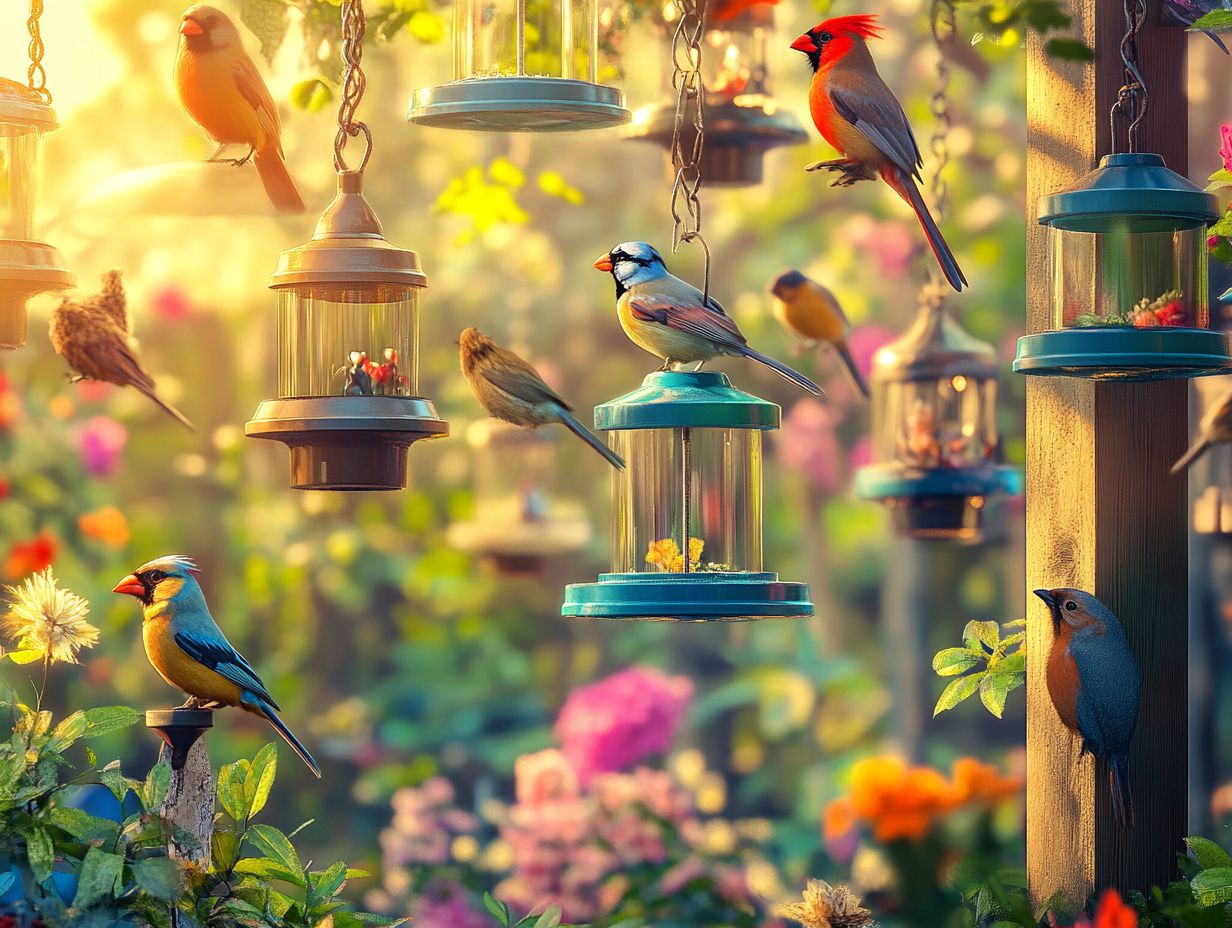
While bird feeders can offer benefits, they also bring several drawbacks for local wildlife. They may unintentionally create ecological challenges, including a dependency on artificial nutrients and heightened avian disease transmission among bird populations, and increase birds’ vulnerability to predators.
Inappropriate feeding practices can create a dependency on artificial nutrients, which might disrupt natural behaviors. If left unmanaged, feeders can lead to habitat loss by attracting certain bird species that upset the ecological balance of local ecosystems.
These feeders can become breeding grounds for common bird diseases, capable of decimating local bird populations. Don’t wait! Regularly clean your feeders to protect local birds, yet many enthusiasts overlook this critical maintenance task.
When feeders attract larger numbers of birds, they can also inadvertently bring in predators like cats or hawks that pose a threat not just to the birds at the feeder but to other species nearby. This leads to conflicts that harm birds and local ecosystems, leading to an unsettling environmental cost that many bird lovers might not anticipate.
How to Properly Use Bird Feeders
To make the most of your bird feeders, it’s essential to follow specific feeding guidelines that enhance bird health while minimizing ecological impacts. The impact of bird feeders on local wildlife can be a double-edged sword, influenced by factors such as feeder design, maintenance, and the surrounding environment.
Regularly cleaning your feeders is key to keeping birds healthy! Grasping the nutritional needs of various bird species will also elevate your birdwatching experience.
By embracing these practices, you can nurture vibrant avian communities and make a positive contribution to your local ecosystems.
Best Practices for Minimizing Negative Impact
Minimizing the negative impacts of bird feeders requires you to implement best practices that ensure the safety and health of wild birds while enhancing your backyard sanctuary. Start by choosing feeder locations that provide shelter from predators. Selecting appropriate food sources that align with the nutritional needs of your local bird species is equally vital, and incorporating native plants will support a balanced wildlife habitat.
To create an ideal environment, position your feeders near dense shrubs or trees for crucial cover from hawks and other predatory birds. Utilizing a variety of feeder types such as tube feeders for small seeds and suet feeders for high-energy fats will cater to the diverse tastes of your feathered friends. Offering a mixture of seeds, like sunflower and millet, will entice a wider range of birds to visit your yard.
Incorporating native plants, like flowering shrubs and perennials, not only attracts pollinators but also enhances the ecological balance by providing natural food sources and nesting sites. Regularly cleaning your feeders is essential for wildlife conservation, as it helps prevent the spread of diseases among visiting birds. By following these thoughtful feeding tips and making mindful landscape choices, you can create a thriving backyard oasis for local avifauna.
Alternatives to Bird Feeders
Exploring alternatives to traditional bird feeders opens the door to a more organic way of attracting birds and nurturing local wildlife. By cultivating a backyard filled with native plants and natural food sources, you elevate your wildlife watching experience and encourage a rich diversity of bird species.
This approach not only helps birds thrive but also improves the ecological balance within your local environment.
Natural Food Sources for Birds
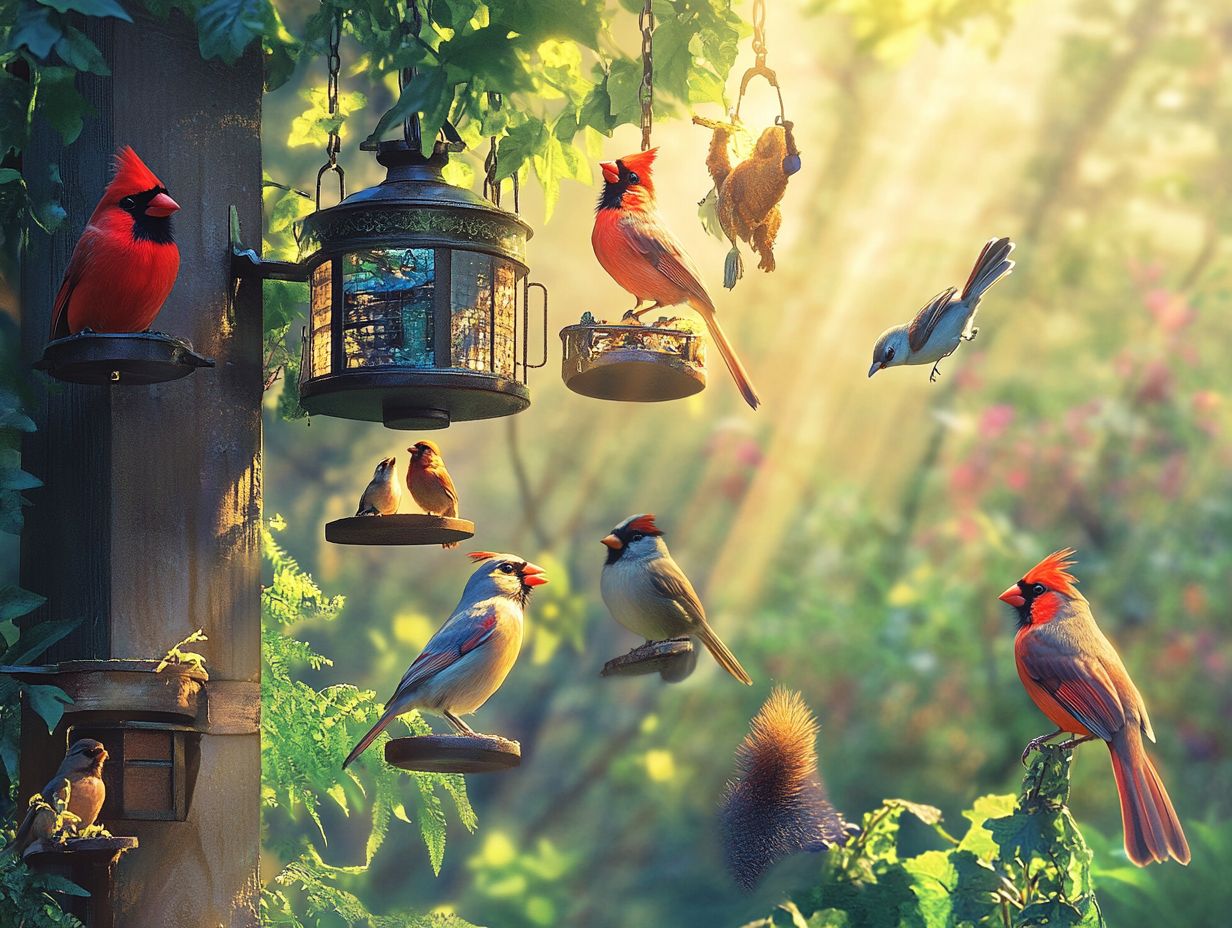
Natural food sources for birds are essential for meeting their nutritional needs and sustaining healthy populations in the wild. By planting native plants that produce seeds, berries, and nectar, you can create a habitat that provides vital food sources for a variety of bird species while supporting insect foragers, which are crucial for many young birds.
This approach not only benefits avian communities but also enhances the ecological integrity of your backyard. For instance, consider planting elderberry and serviceberry, which attract birds like cedar waxwings and robins. Sunflower plants are another excellent choice, drawing in finches with their nutritious seeds. Similarly, native grasses such as little bluestem not only provide seeds for songbirds but also offer cover for nesting.
This diversity of plant life cultivates a more vibrant community composition, encouraging the presence of various species while promoting the natural habitat that food-producing plants create. Ultimately, by fostering such environments, you help sustain the delicate balance that supports both the birds and their ecosystem.
Other Ways to Attract Birds to Your Yard
Attracting birds to your yard goes beyond the usual feeders; it’s about creating an inviting oasis with shelter, water, and varied habitats. By incorporating features like bird baths, nesting boxes, and lush shrubbery, you can cultivate an environment that welcomes a diverse array of bird species, all while enhancing your wildlife watching experiences and encouraging natural bird behaviors.
When you thoughtfully design your backyard sanctuary, you foster thriving avian communities. Integrating a variety of plant species not only provides essential food sources but also offers natural cover for birds seeking refuge from predators.
Consider adding a small pond or even a simple bowl of fresh water these can be transformative, especially in hot weather, as birds instinctively flock to hydration spots. By placing these elements at different heights, you’re likely to attract an even wider range of species, enriching your birdwatching experience.
Your dedication to nurturing diverse habitats will draw a splendid assortment of feathered friends to your space!
Frequently Asked Questions
What is the impact of bird feeders on local wildlife?
Bird feeders can have a positive impact on local wildlife by providing a reliable food source for birds, especially during harsh weather conditions or in areas with limited natural food sources.
Are there any negative effects of bird feeders on local wildlife?
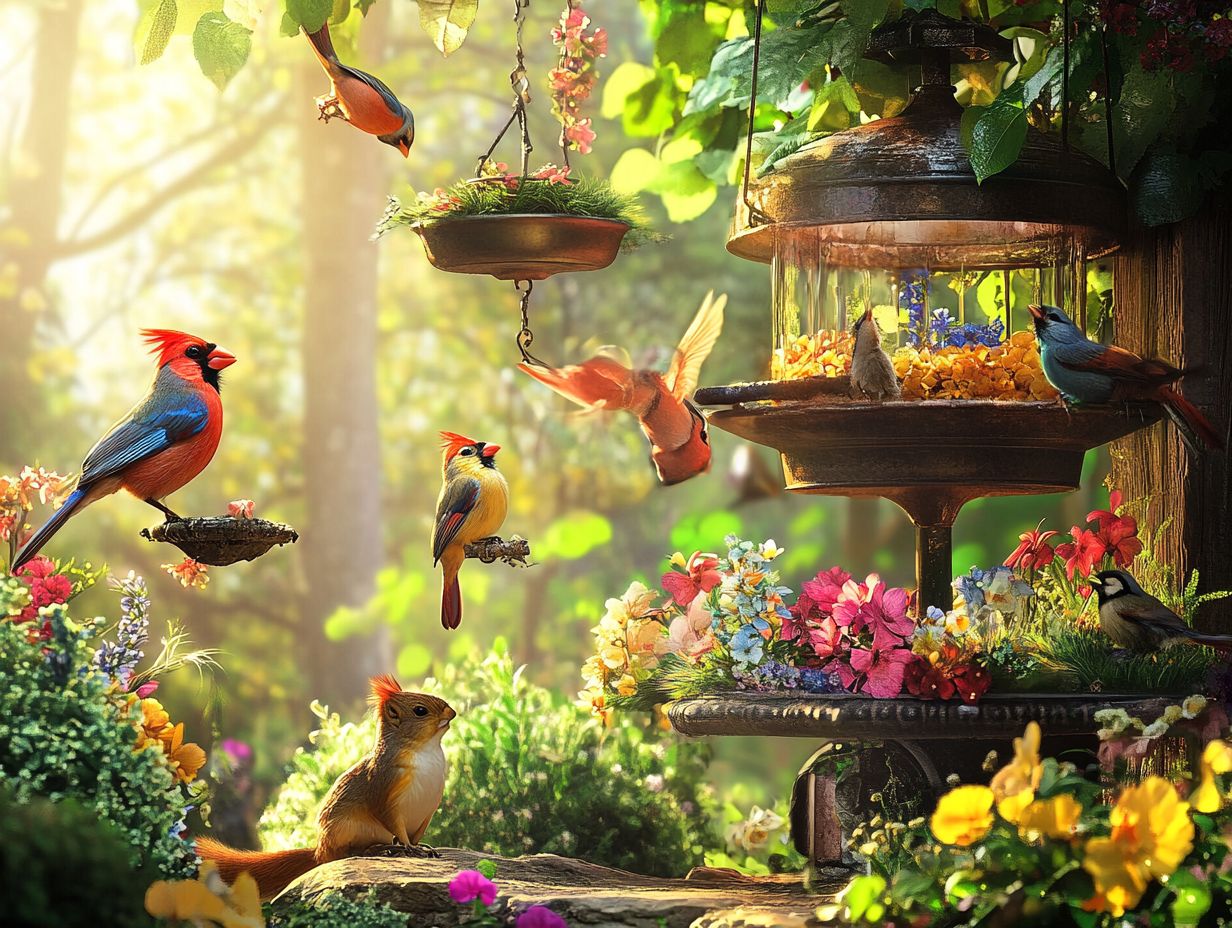
Yes, bird feeders can also have negative effects on local wildlife if not managed properly. They can attract non-native or invasive species, cause overcrowding and competition for food, and spread diseases among birds.
How do bird feeders affect the behavior of local wildlife?
Bird feeders can alter the natural behavior of local wildlife by conditioning birds to rely on human-provided food instead of foraging for their own food. This can lead to a decrease in natural foraging skills and a reliance on artificial food sources.
Start creating your bird-friendly backyard today!
Want to protect local wildlife while enjoying your bird feeders? Here s how!
Regularly clean and maintain your feeders. Use the right bird food to keep wildlife healthy.
Do bird feeders attract other types of wildlife besides birds?
Yes! Bird feeders can also draw squirrels, raccoons, or even bears. These visitors can create conflicts and harm both wildlife and humans.
Manage your feeders wisely to avoid these issues.
Can I still feed birds without using a bird feeder?
Absolutely! You can attract birds by planting native plants and flowers.
Providing a water source and a safe habitat for nesting is also effective.

